“Of all flowers, me thinks a rose is best.” wrote William Shakespeare in The Two Noble Kinsmen. In their new book Roses in the Fire of Spring: Better Roses for a Warming World and Other Garden Adventures (Running Head, 2023), world-renowned rose hybridisers M.S. Viraraghavan and Girija Viraraghavan record their journey of over fifty years, creating more than a hundred new rose varieties, in a range of colours, shapes and types.
Featured here are seven different roses of theirs.
1. ‘Ahimsa’: This is called ‘Orient Silk’ outside India, while having the classic rose (Hybrid Tea or HT) shape, is remarkable for the fact that it has no prickles (thorns), unusual for a rose. It celebrates the central Buddhist/Hindu tenet of non-violence, adopted by Mahatma Gandhi during India’s freedom movement.
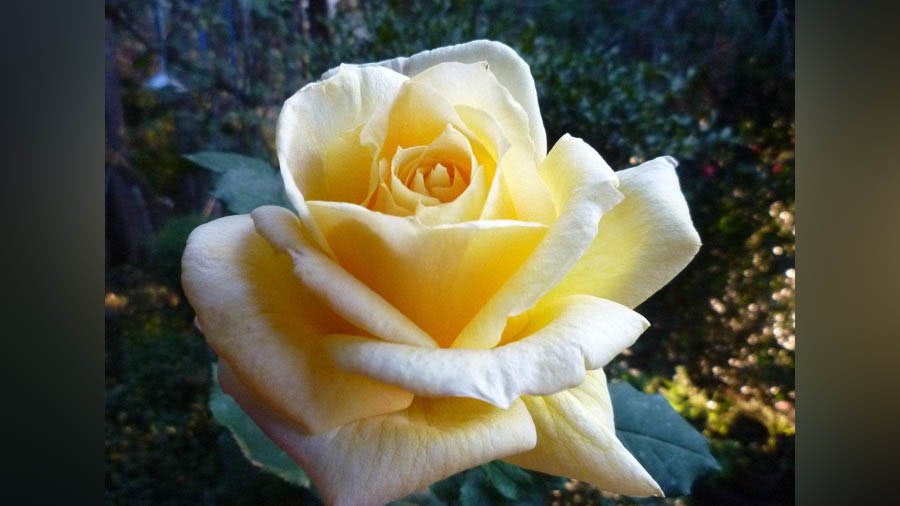
Ahimsa
2. ‘E.K. Janaki Ammal’: This is a fragrant, saffron to yellow rose with pink overtones, and named for India’s pioneering woman botanist, known to be fond of saris of this hue. Co-author of the Chromosome Atlas of Cultivated Plants (1945), Janaki Ammal (1897-1984) was the first woman to earn a PhD in botany, in 1931, from the University of Michigan. She worked at the John Innes Institute, at Kew, and at the Royal Horticultural Society’s garden at Wisley in the UK, apart from the Botanical Survey of India, and her contribution to the field of botany is recognised worldwide.
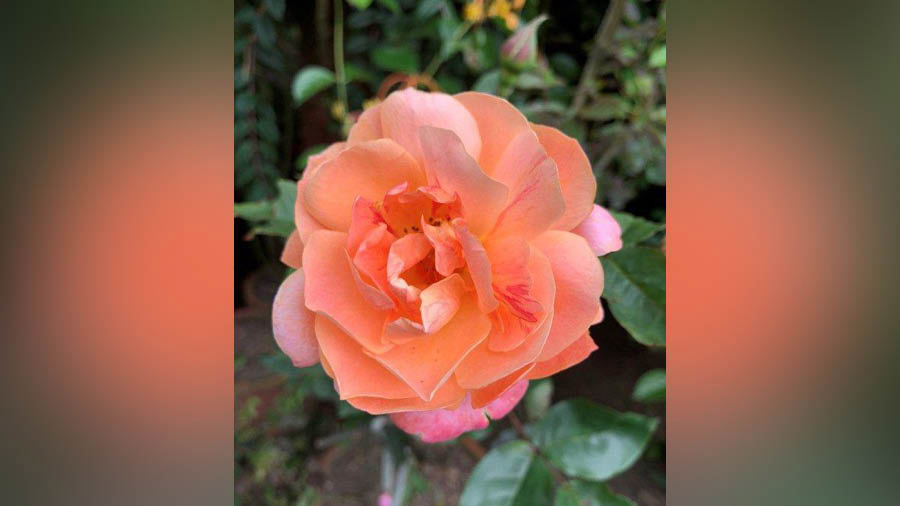
E.K. Janaki Ammal
3. ‘Vanamali’: With its classic rose shape, this rose evokes the hue of Lord Krishna, another of whose names it is, as depicted in the paintings of the royal painter of Kerala, Raja Ravi Varma. The buds are of a clear dark mauve and turn to flowers of lavender, and have a distinct ‘rose’ fragrance.

Vanamali
4. ‘Kanyakumari’: This is a coral-shaded salmon-coloured climbing rose named for the goddess whose temple oversees the far south of India, at land’s end. The place of the same name is considered sacred for it is here that the waters of three oceans, the Indian Ocean, the Arabian Sea and the Bay of Bengal, meet and merge.

Kanyakumari
5. ‘Golden Threshold’: This is a climbing rose named to honour the memory of Sarojini Naidu, famous twentieth-century Indian poet and freedom-fighter, whom Mahatma Gandhi called the ‘Nightingale of India’. It is the name of her house in Hyderabad, as also of a collection of her poems. In traditional Indian homes, it was customary for the threshold to be coated with turmeric paste for both auspicious and antiseptic reasons. For the Viraraghavans, this golden rose represents a crossing over to better, more evergreen roses that could thrive in warm climates.
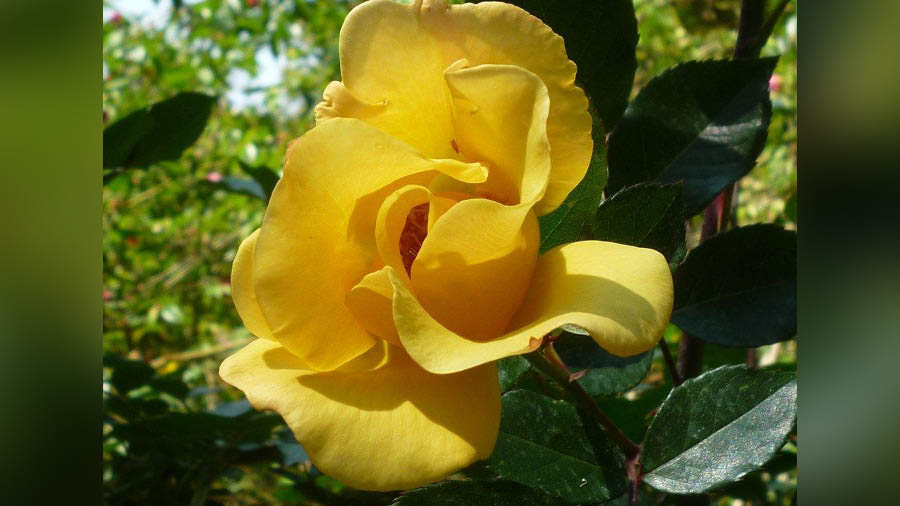
Golden Threshold
6. ‘Karrie’s Rose’: This is named for a dear friend of the couple in the US who is an avid rose grower. This small climbing rose flowers all through the year in saffron, brown and orange. In its complicated lineage are the Viraraghavans’ own ‘Golden Threshold’, and the great American hybridiser Ralph Moore’s ‘Roses are Red’, which is a hybrid of Rosa persica, the wild rose of Persia (Iran).

Karrie’s Rose
7. ‘Naga Belle’: With its classic rose shape, ‘Naga Belle’ is the Viraraghavans’ affectionate tribute to their memories of Manipur, and to its charming women. It was here that they discovered Rosa gigantea in the wild in 1990, which set them off on their journey to produce roses suitable for growing in warm climates. This rose, which grows sometimes singly, and at other times in clusters, won the American AGRS Award in 2019.
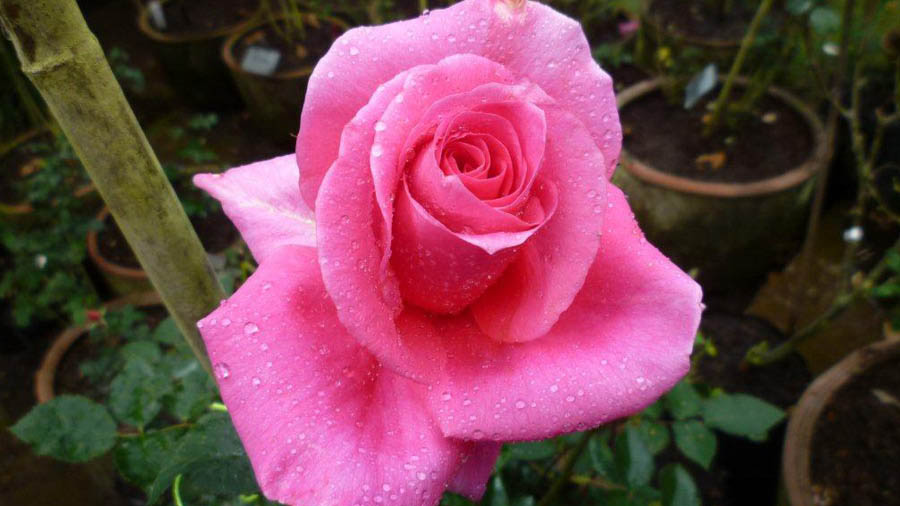
Naga Belle
Shantanu Ray Chaudhuri talks roses and thorns with the rose hybridisers on behalf of My Kolkata:
Shantanu Ray Chaudhuri: The passion for roses goes back a long way – can you recall the first moments when you realised that this was a ‘calling’ you had to follow? Any epiphanic moment that leaps to the mind?
From quite a young age, Viraraghavan was fascinated with roses, but the epiphanic moment was really when his family spent summer vacations in Coonoor, staying at the government guest house within Sim’s Park, which overlooked a rose garden. Every morning, he would wander about this garden which was a blaze of colour of the new roses created from the golden rose of Persia, R. foetida by Pernet Ducher, a great French rose breeder. The brilliant, never-before-seen colours of these roses amazed him – from bright gold and apricot to dazzling oranges and reds. In particular, one of the golden roses took his breath away – ‘Julien Potin’, aptly named for a jeweller – its vivid colour was quite overwhelming for the boy of thirteen, already thrilled with roses. From this came the intoxicating thought: ‘If Pernet Ducher could do it, why not I?’
There’s a delightful little bit about Viraraghavan sir’s viva-voce for the IAS and how his knowledge of roses played an important part in him getting through that. Would you like to share that with our readers?
A difficult part of the IAS examination is the viva-voce, where a panel of senior administrators question the aspirant about various aspects of his or her life and ambitions. Viraraghavan was in the middle of this interview when the Chairman, by chance a learned rose grower, asked him what his hobbies were. ‘Growing roses,’ was the response. The next question was meant to be a googly to confuse a nervous candidate. ‘What roses can you grow in Madras City?’ But Viraraghavan had read the Complete Gardening in India by K.S. Gopalaswamiengar, well-known horticulturist of Bangalore, many times, so my answer was nearly verbatim from the chapter on various kinds of roses which do well in low-to-medium elevations, i.e., warm climates, so he reeled off the different rose classifications: Teas, Noisettes, Bourbons, Chinas, Hybrid Teas, Hybrid Perpetuals. The interview committee then decided it was prudent to go on to other questions rather than get a lecture from a young and seemingly unflurried candidate! But his capacity to master detailed information on various subjects had been noted, and he came through with flying colours (pun intended).
You mention making your presence on the world stage as late as 2000. Please give us a brief account of your work on roses before and after – a potted highlights package, if one can call it. Is there an abiding regret that has remained through your careers?
From the start, our rose breeding focused on creating better roses for warm climates based on the dictum of India’s pioneer rose breeder, B.S. Bhatcharji of Bengal and Bihar. After perusal of many books on roses, we realised the potential in two Indian rose species Rosa gigantea (from northeast India) and Rosa clinophylla (perhaps the world’s only tropical rose species). In 1999, at what happened to be a World Regional Rose Convention, in Jaipur, Viraraghavan’s talk, as always, focused on the breeding with the two rose species mentioned. After the talk, the World Federation of Rose Societies President, Helga Brichet, and Vice-President (South America), Mercedes Villar, came up to him and said they had never before heard of this kind of rose work or of these rose species and invited him to be a speaker at the next World Rose Convention to be held in May 2000 in Houston, Texas.
That was the start of a further phase of rose breeding with the realisation that other than India, several warm parts of the world were also looking for roses that would do well there. These two rose species had been personally collected by us from their native habitat. At Houston, and in other places, people were fascinated by this aspect, which no earlier breeder had undertaken, that is, personally collecting rose species in the wild, at great risk, growing them and using them in creating new roses; starting from scratch as it were. It made sense to them when Viraraghavan explained the dictum of that great German breeder Wilhelm Kordes I who said, ‘The soup ladle will only bring out what is already in the tureen’, meaning that fresh genetic input was required if new and different roses are to be created. The enthusiastic response to his ideas strengthened his determination to go ahead with this new rose breeding line. There is nothing as intoxicating as the realisation that the rose world is watching our work with great interest.
As for an abiding regret, that’s all too easy to answer. It’s the systematic neglect of Indian-bred roses by the rose-growing public of India, who remain fascinated by roses raised in Europe and the U.S. though they are utterly unsuited for Indian climates. This unreasonable preference for foreign rose varieties is part of the general craze for all things foreign. Fortunately, more recently, there has been a change, and young rose breeders and growers are realising that Indian bred roses do better in the heat and are slowly beginning to grow these.

Girija Viraraghavan and M.S. ‘Viru’ Viraraghavan
M.S. Viraraghavan and Girija Viraraghavan take us through other roses to which they have given evocative names. Some of these are:
‘Kindly Light’: This name was given to a lovely white shading to soft pink rose after the hymn ‘Lead, Kindly Light’, a favourite of Mahatma Gandhi’s. The Viraraghavans have the practice of giving two names to some of our roses, one better understood in India, if it is a Sanskrit word, and one for the West. This rose is named ‘Swami Vinayananda’ in India, for a monk of the Ramakrishna Mission order. He was a great plantsman, his book on dahlias is a definitive work on all aspects of dahlia growing and he was a very good rose grower.
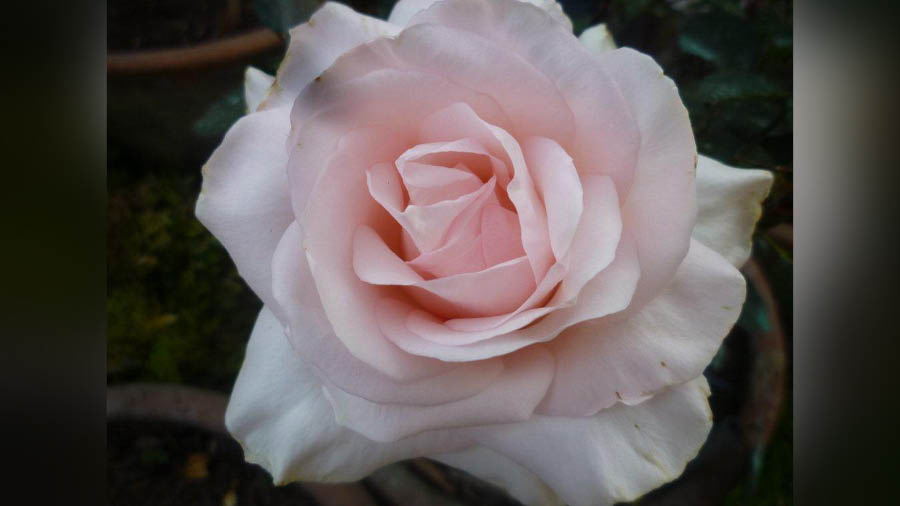
Kindly Light
‘Meghamala/Wine-dark Sea’: One more example of two names for a rose, Meghamala translates as ‘garland of clouds’. The name for this rose was inspired by the purple garland-like pattern, reminiscent of clouds, on the petals of this rose, which otherwise are dark orange-red in colour. ‘Meghamala’ is from a line by Devulapalli Krishna Sastri, beloved modern poet of the Telugu language, to whom the rose is a tribute. ‘Wine-Dark Sea’ derives from Homer’s epithet, in both the Iliad and Odyssey, of the purple shadows of approaching night on the orange-red waters reflecting the rays of a setting sun on the Aegean Sea.

Meghamala/Wine-dark Sea
‘Allegory of Spring’: A very special light-pink rose with intriguing pointed petals was named by the Viraraghavans after the famous Botticelli painting La Primavera, also called ‘Allegory of Spring’.
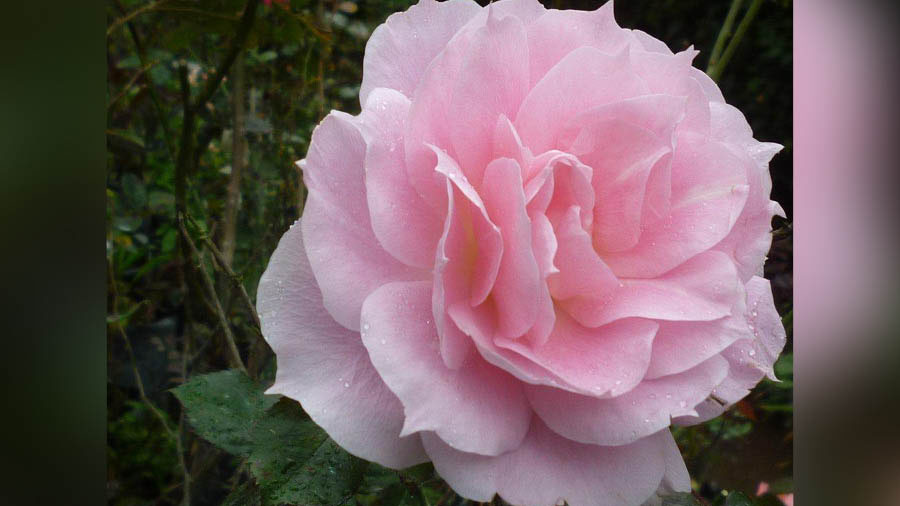
Allegory of Spring
‘Incense Indigo’: An indigo purple rose with an enticing fragrance was the inspiration for this name.

Incense Indigo
‘Twilight Secret’ and ‘Twilight Tryst’: These are two purple-hued roses that remind one of the late evening, shadowy light, romantic secrets and trysts.

‘Twilight Secret’ and ‘Twilight Tryst’
‘Kusabue’s Guardian Angels’: Kusabue is the name of a rose garden in Sakura City, Japan, entirely looked after by volunteers, all very senior citizens. This is our tribute to them.
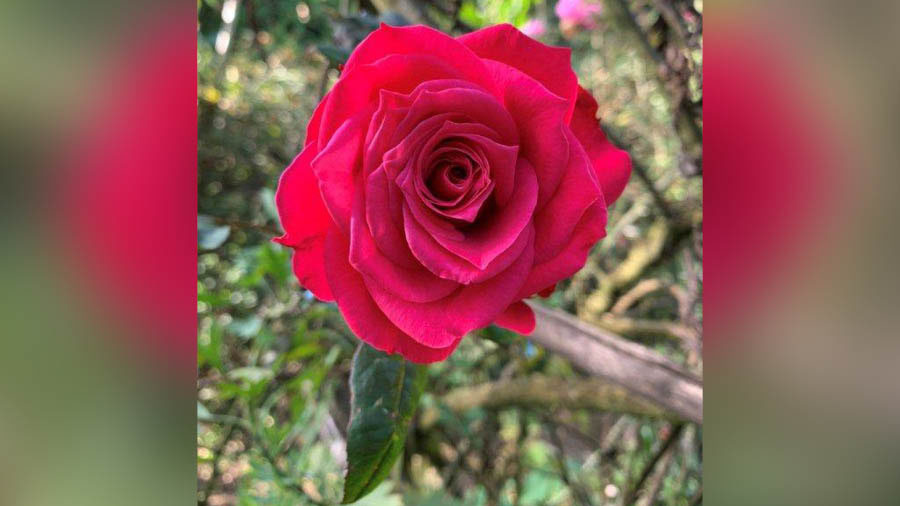
Kusabue’s Guardian Angels
